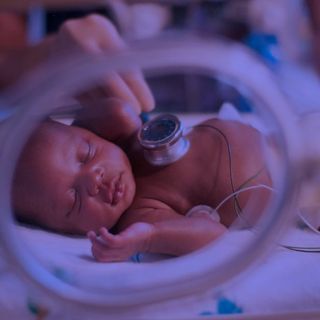
One Woman Is Challenging Instagram’s Childbirth Ban
How do you feel about a stranger’s vagina in your feed?

At the end of 2017, Los Angeles-based nurse, Katie Vigos decided to launch a petition to allow uncensored images of childbirth on Instagram. Three years earlier, Vigos had started an account called the Empowered Birth Project, with the aim of normalizing realistic pictures of pregnancy and childbirth.
Her page has since garnered almost 300,000 followers, The Guardian recently reported, but Instagram often removes the images she posts, on the grounds of offensive content.
“The female body in the midst of giving birth – blood, pubic hair, buttocks, the image of a baby exiting a woman’s vagina – seems to trigger people to report images,” said Vigos, a registered nurse and doula, in an interview with The Guardian. “But there is no reason why we shouldn’t be able to show photos of physiological birth. It’s straight-up censorship.”
Late last year, when Vigos reposted a photo of a fellow Instagram user in the throes of delivery, it became her top-liked post. Soon after, the post was removed by the site, and Vigos responded with her petition. Within a week, it had received 15,000 signatures; as of The Swaddle’s press time, it has reached more that 22,000 signatures.
Instagram policy toward visuals of genitals is subjective, and determined by context. According to the site’s guidelines: “[W]e don’t allow nudity on Instagram. This includes photos, videos and some digitally created content that show sexual intercourse, genitals and close-ups of fully nude buttocks. It also includes some photos of female nipples, but photos of post-mastectomy scarring and women actively breastfeeding are allowed. Nudity in photos of paintings and sculptures is OK, too.”
Breasts are, apparently, okay; accounts like the NSFW @breastacademy, an Australian plastic surgeon specializing in breast augmentation, and like the NSFW @claudiasahuquillo, an artist, frequently post images of mostly or entirely nude women, with no intervention from Instagram. Other accounts like @surgerpics (NSFW and click only if you have a strong stomach) are dedicated to explicit displays of surgical procedures, though some particularly graphic photos are blurred and are only revealed fully if followers choose to click on the image.
The fact that these accounts’ images are allowed, and hers are not, says one thing to Vigos.
“They’re saying because genitals are involved in childbirth [this type of image] belongs in pornography,” she told The Guardian.
Vigos says Instagram’s line in the sand arises from biased social beliefs that a woman’s body is only acceptable in a certain, desirable way — that women’s vaginas are “only okay when they’re clean, tight and hairless,” Vigos said.
Nudity, particularly female nudity, in public places has always been regulated — and challenged — and it’s not surprising this debate is now playing out on public, if virtual, platforms. But the arbiters in today’s public spaces are private companies, not governments, which means, perhaps, that the process of defining the guidelines that inform our new norms are more opaque.
Instagram has not yet responded publicly to Vigos’ petition, but its response to the ‘Free the Nipple’ movement, popular a few years ago, offers clues to how it might handle her challenge. In an interview back in 2015, Instagram CEO and co-founder Kevin Systrom said Instagram was bound by the rules of the Apple Store, through which the Instagram app is offered, which rates any app that allows nudity 17+, thus barring a lot of the photo-sharing platform’s younger users. (Instagram allows users as young as 13 to hold an account.)
Vigos acknowledges graphic images of childbirth may not be for everyone, but contends a more reasonable solution than banning them would be to blur them until a user clicks on them, as the most graphic images in the @surgicalpics account and others appear. That way, the images are still available to empower women with accurate knowledge they may not find elsewhere.
“People can’t conceptualise a vagina opening for a baby to pass through,” she told The Guardian, “and that leads to fear and tension during labour, which inhibits the birth process.”
Angelina Shah is a staff writer with The Swaddle. In her previous life she was a copywriter in advertising. She has a penchant for reading, singing, travelling and being obsessed with superheroes.
Related


Scientists Get Rare Peek at Premies’ Brain Development
